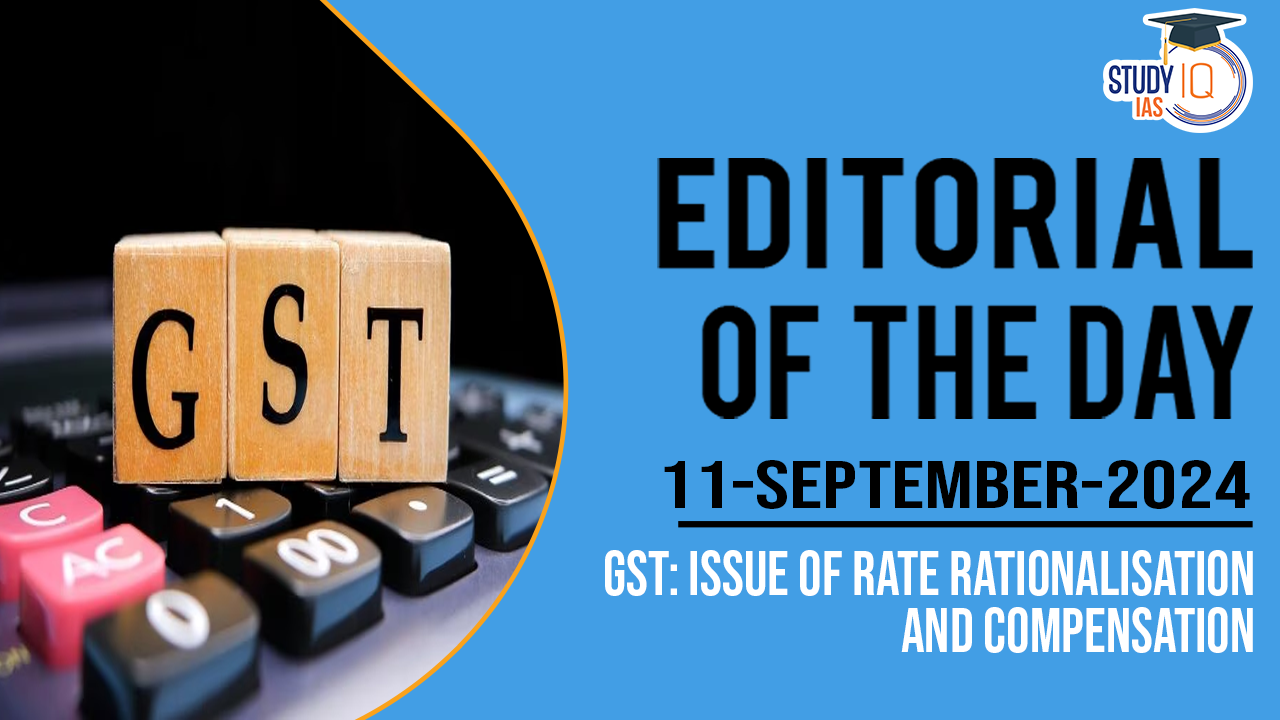Table of Contents
Context: Recently, the 54th GST Council meeting was held under the leadership of Union Finance Minister Nirmala Sitharaman.
Some Highlights of 54th GST Council Meeting
- Tax on extruded or expanded products was reduced from 18% to 12%.
- Exemption from income tax on research and development funds received by state or central universities or institutions was granted.
- The GST Compensation Cess was extended till March 2026.
- A Group of Ministers is expected to work on the rate rationalisation issue.
What is the GST Council?
- It is a joint forum consisting of representatives from both the Centre and the states.
- It was established by the President in accordance with Article 279A(1) of the amended Constitution.
- Members:
- Chairperson: Union Finance Minister
- Other Members: Union Minister of State for Finance
- Each state is allowed to nominate a minister responsible for finance, taxation, or any other relevant minister to represent them in the Council.
- Functions
- Responsible for recommending important GST-related matters to the Union and the states.
- This includes advising on which goods and services should be subjected to or exempted from GST and creating model GST laws.
- The Council also determines the various rate slabs for GST.
- Example: In 2024, it lowered the tax rate on certain cancer drugs (Trastuzumab Deruxtecan, Osimertinib, Durvalumab) from 12% to 5%.
- Responsible for recommending important GST-related matters to the Union and the states.
| Fact |
| Currently, GST is applicable in 4 slabs: 5%, 12%, 18% and 28%. |
What is GST Rate Rationalisation?
- GST rate rationalisation refers to the process of reviewing, revising, and simplifying GST rates for various taxable items.
- This is done during the GST Council’s quarterly meetings with members to streamline the tax structure.
- Purpose: To reduce complexity in the GST system and make it more efficient.
- Aims:
- Reducing GST rates for essential and semi-essential items.
- Shifting items from one tax category to another based on consumption patterns.
- Reducing the number of tax slabs to simplify the tax system.
- Eliminating confusion over different tax rates applied to similar items.
Why is there a need for Rationalisation?
- Structural Simplification of GST Rates: Many countries that have successfully implemented GST use only one or two tax slabs, indicating that there is significant room for improvement in India’s GST structure.
- Review Based on Consumption Patterns: Since GST is a consumption-driven tax, it is important to regularly review and revise rates in accordance with changing consumption patterns.
- Reducing Tax Burden on Essential Items: It plays a crucial role in lowering the tax burden on essential items, helping to curb price inflation.
- Minimising Compliance Burden: The presence of multiple tax slabs creates confusion and increases the compliance and audit burden for manufacturers and traders.
- Simplifying the tax rates through rationalisation can help reduce operational costs for businesses.
Impact of GST Rate Rationalisation
- Improve Ease of Doing Business: It will simplify tax processes for manufacturers and traders.
- Achieve “One Nation, One Market”: Removing interstate obstacles will facilitate smoother goods transfer across India.
- Reduce Compliance Burden: Manufacturers and traders will face fewer tax complexities and reduced compliance costs.
- Increase Voluntary Tax Compliance: A simplified GST structure will lead to higher taxpayer participation.
- Boost Government GST Collection: More efficient tax processes can result in increased revenues for the government.
Challenges in Rationalising GST Rates
- Diverse Consumption Patterns: India’s varied consumption habits across states make it challenging to build consensus on tax reforms.
- Two-thirds of voting rights in the GST Council belong to states, making alignment difficult.
- Impact on State Revenues: Proposals such as bringing petroleum products under GST face opposition from states that would lose revenue, creating political disagreements.
- Tax Collection Concerns: Any reduction in GST rates for certain goods must be offset by increases elsewhere.
- With luxury goods already taxed at high rates, there is limited room for adjustments without causing inflation.
- Inflation and Economic Impact: Merging the 12% and 18% slabs to a 15% median rate would increase the tax burden on goods currently taxed at 12%, potentially fueling inflation and impacting consumers.
- Implementation Complexity: Merging tax slabs requires cooperation between multiple government agencies, which is time-consuming and costly.
| Compensation Cess under GST |
|
Way Forward
- Consensus Building Among States: Engaging states in discussions about the impact of GST rationalisation on their revenues can help align interests.
- Gradual Implementation of Rate Changes: A phased approach to rationalising GST rates is recommended to avoid shocks.
- Addressing Revenue Concerns for States: To alleviate states’ revenue loss fears, compensatory mechanisms could be explored, such as allocating GST revenues to local bodies.
- Simplifying GST Classification: Focus on standardising product classifications to eliminate confusion and disputes.
- Example: resolving the classification issues between flavoured milk and beverages, which currently face different tax rates, will simplify compliance.
- Monitoring Economic Impact: Implement a monitoring framework to assess the economic impact of rate changes, particularly on inflation and consumer behaviour.


 Bharat Bandh 9 July 2025: Over 25 Crore ...
Bharat Bandh 9 July 2025: Over 25 Crore ...
 Sukhoi Su-57: Will India Choose Russia�...
Sukhoi Su-57: Will India Choose Russia�...
 World Bioproduct Day 2025: Date, Theme, ...
World Bioproduct Day 2025: Date, Theme, ...





















